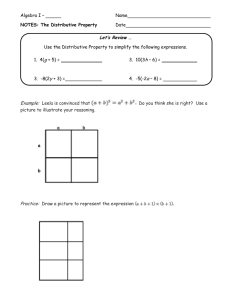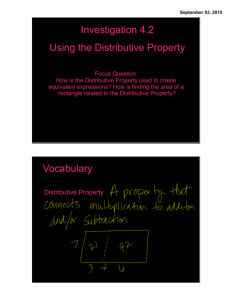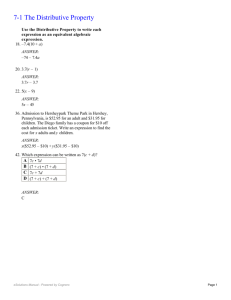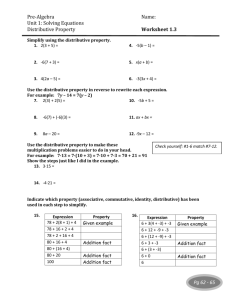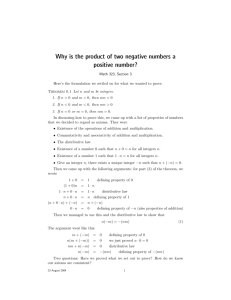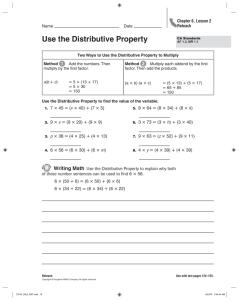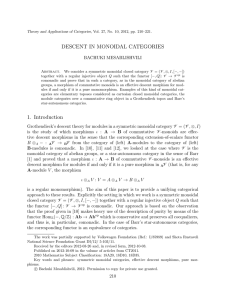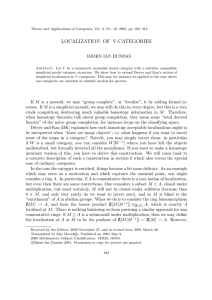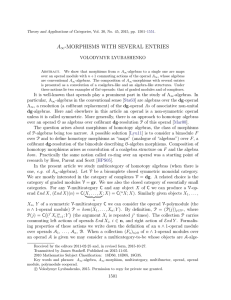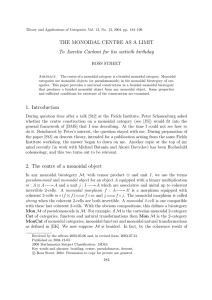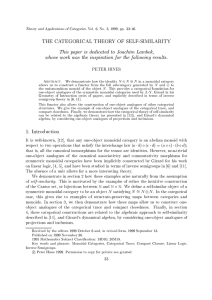NOTE ON STAR-AUTONOMOUS COMONADS CRAIG PASTRO
advertisement
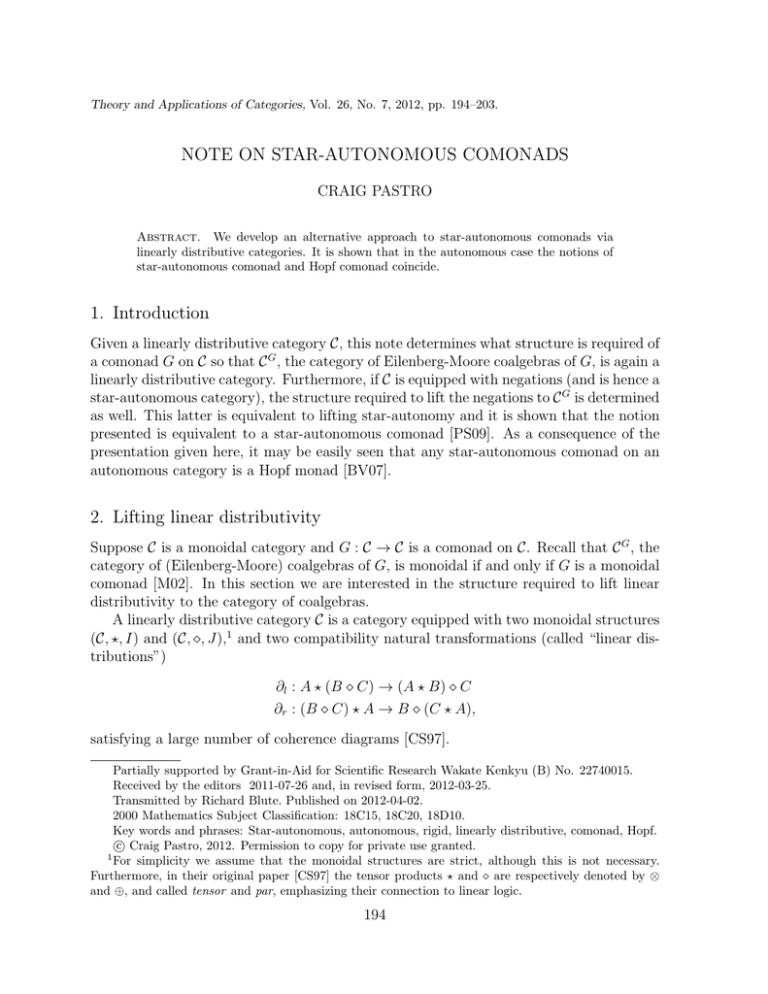
Theory and Applications of Categories, Vol. 26, No. 7, 2012, pp. 194–203.
NOTE ON STAR-AUTONOMOUS COMONADS
CRAIG PASTRO
Abstract. We develop an alternative approach to star-autonomous comonads via
linearly distributive categories. It is shown that in the autonomous case the notions of
star-autonomous comonad and Hopf comonad coincide.
1. Introduction
Given a linearly distributive category C, this note determines what structure is required of
a comonad G on C so that C G , the category of Eilenberg-Moore coalgebras of G, is again a
linearly distributive category. Furthermore, if C is equipped with negations (and is hence a
star-autonomous category), the structure required to lift the negations to C G is determined
as well. This latter is equivalent to lifting star-autonomy and it is shown that the notion
presented is equivalent to a star-autonomous comonad [PS09]. As a consequence of the
presentation given here, it may be easily seen that any star-autonomous comonad on an
autonomous category is a Hopf monad [BV07].
2. Lifting linear distributivity
Suppose C is a monoidal category and G : C → C is a comonad on C. Recall that C G , the
category of (Eilenberg-Moore) coalgebras of G, is monoidal if and only if G is a monoidal
comonad [M02]. In this section we are interested in the structure required to lift linear
distributivity to the category of coalgebras.
A linearly distributive category C is a category equipped with two monoidal structures
(C, ⋆, I) and (C, ⋄, J),1 and two compatibility natural transformations (called “linear distributions”)
∂l : A ⋆ (B ⋄ C) → (A ⋆ B) ⋄ C
∂r : (B ⋄ C) ⋆ A → B ⋄ (C ⋆ A),
satisfying a large number of coherence diagrams [CS97].
Partially supported by Grant-in-Aid for Scientific Research Wakate Kenkyu (B) No. 22740015.
Received by the editors 2011-07-26 and, in revised form, 2012-03-25.
Transmitted by Richard Blute. Published on 2012-04-02.
2000 Mathematics Subject Classification: 18C15, 18C20, 18D10.
Key words and phrases: Star-autonomous, autonomous, rigid, linearly distributive, comonad, Hopf.
c Craig Pastro, 2012. Permission to copy for private use granted.
⃝
1
For simplicity we assume that the monoidal structures are strict, although this is not necessary.
Furthermore, in their original paper [CS97] the tensor products ⋆ and ⋄ are respectively denoted by ⊗
and ⊕, and called tensor and par, emphasizing their connection to linear logic.
194
195
NOTE ON STAR-AUTONOMOUS COMONADS
Suppose G = (G, δ, ϵ) is a comonad on a linearly distributive category C which is a
monoidal comonad on C with respect to both ⋆ and ⋄, with structure maps (G, ϕ, ϕ0 ) and
(G, ψ, ψ0 ) respectively. If, for G-coalgebras A, B, and C, the comonad G satisfies
GA ⋆ (GB ⋄ GC)
1⋆ψ
/ GA ⋆ G(B ⋄ C)
ϕ
/ G(A ⋆ (B ⋄ C))
∂l
∂l
(GA ⋆ GB) ⋄ GC
ϕ⋄1
/ G(A ⋆ B) ⋄ GC
ψ
(1)
/ G((A ⋆ B) ⋄ C),
it may be seen that the morphism ∂l becomes a G-coalgebra morphism. If G satisfies a
similar axiom for ∂r , i.e.,
(GB ⋄ GC) ⋆ GA
ψ⋆1
/ G(B ⋄ C) ⋆ GA
ϕ
/ G((B ⋄ C) ⋆ A)
∂r
∂r
GB ⋄ (GC ⋆ GA)
1⋄ϕ
/ GB ⋄ G(C ⋆ A)
ψ
(2)
/ G(B ⋄ (C ⋆ A)),
then ∂r also becomes a G-coalgebra morphism. Thus,
2.1. Proposition. Given a linearly distributive category C and a comonad G : C → C
satisfying axioms (1) and (2), the category C G is a linearly distributive category.
2.2. Example. Let C be a symmetric linearly distributive category and (B, µ, η, δ, ϵ) a
bialgebra in C with respect to ⋄. That is, the structure morphisms are given as
µ:B⋄B →B
η:J →B
δ :B →B⋄B
ϵ : B → J.
Then, G = B ⋄ − is a comonad and is monoidal with respect to both ⋄ and ⋆. The latter
η⋄1
via I ∼
= J ⋄ I −−→ B ⋄ I, and the following,
∂
(B ⋄ U ) ⋆ (B ⋄ V ) −−−−r−−→ B ⋄ (U ⋆ (B ⋄ V ))
1 ⋄ (1 ⋆ c)
−−−−−−→ B ⋄ (U ⋆ (V ⋄ B))
1⋄∂
−−−−−l−→ B ⋄ ((U ⋆ V ) ⋄ B)
1⋄c
−−−−−−→ B ⋄ (B ⋄ (U ⋆ V ))
∼
=
−−−−−−→ (B ⋄ B) ⋄ (U ⋆ V )
µ⋆1
−−−−−−→ B ⋄ (U ⋆ V ).
Rather large diagrams, which we leave to the faith of the reader, prove that B ⋄ − satisfies (1) and (2), so that C B = ComodC (B), the category of comodules of B, is a linearly
distributive category.
196
CRAIG PASTRO
3. Lifting negations
Suppose now that C is a linearly distributive category equipped with negations S and S ′
(corresponding to ⊥ (−) and (−)⊥ in [CS97]). That is, functors S, S ′ : C op → C together
with the following (dinatural) evaluation and coevaluation morphisms
e′
e
A
A ⋆ S ′ A −→
J
A
SA ⋆ A −→
J
n′A
nA
I −→ A ⋄ SA
(3)
′
I −→ S A ⋄ A,
satisfying the four evident “triangle identities”. One such is
(
)
n⋆1
∂r
1⋄e
A∼
→ A ⋄ (SA ⋆ A) −−→ A ⋄ J ∼
= I ⋆ A −−→ (A ⋄ SA) ⋆ A −
= A = 1A .
If C is equipped with such negations we say simply that C is a linearly distributive category
with negations.
We are interested to lift negations to C G . This means we must ensure that the “negation” functors S, S ′ : C op → C lift to functors (C G )op → C G , and the evaluation and
coevaluation morphisms are in C G , i.e., are G-coalgebra morphisms.
The following is essentially known from [S72].
3.1. Proposition. A (contravariant) functor S : C op → C may be lifted to a functor
Se : (C G )op → C G such that the diagram
(C G )op
e
S
/ CG
U
U
C
op
/ C,
S
(in which U : C G → C is the underlying functor) commutes, if and only if there is a
natural transformation
ν : S → GSG
satisfying the following two axioms
/ GSG
S GG
GG
GG
GG
ϵSG
G
Sϵ GGG
GG
# SG
ν
/ GSG
S GG
GG
GG
GG
ν GGG
GG
G#
GSG
ν
δSG
/ G2 SG
O
G2 Sδ
GνG
(4)
/ G2 SG2 .
This may be viewed as a distributive law of a contravariant functor over a comonad [S72].
In this case, we say that S may be lifted to C G , and a functor Se : (C G )op → C G is defined
as
(
)
GSγ
ν
e
e ) = Sf.
S(A,
γ) = SA, SA −
→ GSGA −−→ GSA
S(f
197
NOTE ON STAR-AUTONOMOUS COMONADS
(To see the reverse direction, suppose (A, γ) is a coalgebra and Se is a functor C G → C G ,
e = (SA, γ
so that SA
e) is again a coalgebra. Define
γ
e
GSϵ
A
ν := SA −
→ GSA −−−→
GSGA,
which may be seen to satisfy the axioms in (4).) We will usually let the context differentiate between S and Se and simply write S in both cases.
Now, suppose S and S ′ may be lifted to C G , that is, they are equipped respectively
with natural transformations
ν : S → GSG
and
ν ′ : S ′ → GS ′ G,
satisfying (4). It remains to lift the evaluation and coevaluation morphisms (3). Consider
the following axioms.
eA
/ SA ⋆ A
1⋆ϵ
SA ⋆ GA
/J
ψ0
ν⋆δ
GSGA ⋆ G2 A
I
ϕ0
/ GI
ϕ
/ G(SGA ⋆ GA)
/ G(A ⋄ SA)
Gn
GeGA
G(1⋄Sϵ)
/ GJ
/ G(A ⋄ SGA)
O
n
G(1⋄Sδ)
/ GA ⋄ GSG2 A
1⋄ν
GA ⋄ SGA
ϵ⋆1
GA ⋆ S ′ A
ϕ
/J
δ⋆ν ′
ψ0
G2 A ⋆ GS ′ GA
I
ϕ0
/ GI
Gn′
ϕ
/ G(GA ⋆ S ′ GA)
/ G(S ′ A ⋄ A)
Ge′GA
G(S ′ ϵ⋄1)
S ′ GA ⋄ GA
ν ′ ⋄1
/ GS ′ G2 A ⋄ GA
ϕ
(7)
/ GJ
/ G(S ′ GA ⋄ A)
O
G(S ′ δ⋄1)
n′
(6)
/ G(A ⋄ SG2 A)
e′A
/ A ⋆ S ′A
(5)
(8)
/ G(S ′ G2 A ⋄ A)
3.2. Proposition. Suppose C is a linearly distributive category with negation, G is a
monoidal comonad satisfying axioms (1) and (2) (so that C G is linearly distributive), and
that S and S ′ may be lifted to C G . Then, G satisfies axioms (5), (6), (7), and (8) if and
only if C G is a linearly distributive category with negation.
198
CRAIG PASTRO
Proof. Suppose (A, γ) is a G-coalgebra. We start by proving that axiom (5) holds if
and only if e : SA ⋆ A → J is a G-coalgebra morphism. The following diagram proves the
“only if” direction,
ν⋆γ
SA ⋆ A
/ GSGA ⋆ G2 A
ν⋆δ
SA ⋆ GA
1⋆ϵ
/ G(SGA ⋆ A)
TTTTG(Sγ⋆1)
TTTT
TTTT
*
G(1⋆γ)
1⋆Gγ
1⋆γ
1
ϕ
/ GSGA ⋆ GA
(5)
/J
e
SA ⋆ A
G(SA ⋆ A)
ϕ
/ G(SGA ⋆ GA)
TTTT
Ge
TTTGe
TTTT
TTTT *
ψ0 bbbbbbbbbbbbbbb1 GJ,
b
b
b
b
bbb
bbbbbbbbbbb
and this next diagram the “if” direction
{
{{
1⋆ϵ {{{
Sϵ⋆1
{
{{
{
{} {
SA ⋆ CA SGA ⋆ GA
CC
CC
CC
eGA
C
e CC
CC
C! / GSGA ⋆ G2 A
FF
ϕ
FF
FF 1
GSGϵ⋆1 F
FF
FF
FF
"
GSδ⋆1
/ GSG2 A ⋆ G2 A
/ GSGA ⋆ G2 A
ν⋆δ
SA ⋆ GA
ν⋆δ
ϕ
$
/ G(SGA ⋆ GA)
GeGA
/ GJ,
ψ0
J
where the bottom square commutes as eGA is a G-coalgebra morphism.
Next we prove that axiom (6) holds if and only if n : I → A ⋄ SA is a G-coalgebra
morphism. The “only if” direction is given by
ϕ0
I GG
GG
GG
GGn
GG
n
GG
GG
G#
A ⋄ SA
GA
⋄ SGA
GG
GG
GG
GG
G
γ⋄1 GGG
GG
# / GI
(6)
1⋄ν
1⋄Sγ
GA ⋄ SA
/ G(A ⋄ SA)
Gn
/ GA ⋄ GSG2 A
ϕ
/ GA ⋄ GSGA
/ G(A ⋄ SG2 A)
G(1⋄Sδ)
ϕ
/ G(A ⋄ SGA)
/ G(A ⋄ SGA)
G(1⋄Sγ)
G(1⋄SGγ)
1⋄GSGγ
1⋄ν
G(1⋄Sϵ)
G(1⋄Sγ)
/ G(A ⋄ SA),
1
NOTE ON STAR-AUTONOMOUS COMONADS
199
and the “if” direction by
ϕ0
I
nGA
GA ⋄ SGA
MM
δ⋄ν
/ G2 A ⋄ GSG2 A
MMM
MMM
MMM
1⋄ν MMM
MMM
&
ψ
/ G(GA ⋄ SG2 A)
G(ϵ⋄1)
Gϵ⋄1
GA ⋄ GSG2 A
G(1⋄Sδ)
ψ
/ G(A ⋄ SG2 A)
G(1⋄Sδ)
/ GI
GG
GG
GG Gn
GG
GnGA
GG
GG
G#
/ G(GA ⋄ SGA) G(A ⋄ SA)
ww
ww
w
w
G(ϵ⋄1)
ww
ww G(1⋄Sϵ)
w
{ww
/ G(A ⋄ SGA),
where the top square commutes as nGA is a G-coalgebra morphism.
The remaining two axioms are proved similarly.
4. Star-autonomous comonads
Suppose C = (C, ⊗, I, S, S ′ ) is a star-autonomous category. A star-autonomous comonad
G : C → C is a comonad satisfying axioms (described below) so that C G becomes a starautonomous category [PS09]. In this section we show that comonads as in Proposition 3.2
and star-autonomous comonads coincide.
We recall the definition of star-autonomous comonad [PS09], but, as it suits our needs
better here, we present a more symmetric version. First recall that a star-autonomous
category C = (C, ⊗, I, S, S ′ ) may be defined as a monoidal category (C, ⊗, I) equipped
with an adjoint equivalence
≃
S ⊣ S ′ : C op −
→C
such that
C(A ⊗ B, SC) ∼
= C(A, S(B ⊗ C)),
(9)
natural in A, B, C ∈ C. The functor S is called the left star operation and S ′ the right
star operation.
By the Yoneda lemma, the isomorphism in (9) determines, and is determined by, the
two following “evaluation” morphisms:
e = eA,B : S(A ⊗ B) ⊗ A → SB
and e′ = e′B,A : B ⊗ S ′ (A ⊗ B) → S ′ A.
4.1. Definition. A star-autonomous comonad on a star-autonomous category C is a
monoidal comonad G : C → C equipped with
ν : S → GSG
and
ν ′ : S ′ → GS ′ G,
200
CRAIG PASTRO
satisfying (4) (i.e., S and S ′ may be lifted to C G ), and this data must be such that the
following four diagrams commute.
∼
=
SS ′ G
/G
∼
=
ν
GSGS ′ G
GSν ′
/ GSS ′
S(A ⊗ B) ⊗ GA
1⊗ϵ
∼
=
S ′ SG
∼
=
ν′
GS ′ GSG
GSν
eA,B
/ S(A ⊗ B) ⊗ A
ν⊗δ GSG(A ⊗ B) ⊗ G2 A
G(Sϕ⊗1)
ϵ⊗1
/ G(S(GA ⊗ GB) ⊗ GA)
/ B ⊗ S ′ (A ⊗ B)
G2 B ⊗ GS ′ G(A
⊗ B)
4
e′B,A
/ S ′A
44
44
44ν ′
44
44
GSE ′ GA
′
GeGB,GA
44
44
4
ϕ 44
4
G(GB ⊗ S ′ G(A ⊗ B))
/ SB
44
44
44ν
44
44
GeGA,GB
G(SG(A ⊗ B) ⊗ GA)
δ⊗ν ′ / GS ′ S
GSGB
E
44
44
44
ϕ 44
4
GB ⊗ S ′ (A ⊗ B)
/G
G(1⊗S ′ ϕ)
/ G(GB ⊗ S ′ (GA ⊗ GB))
The first two diagrams above ensure that the unit and the counit of the adjoint equivalence S ⊣ S ′ lifts to C G , while the latter two diagrams above respectively ensure that e
and e′ are G-coalgebra morphisms, so that the isomorphism (9) also lifts to C G .
We wish to show that star-autonomous comonads and comonads as in Proposition 3.2
coincide. It should not be surprising considering the following theorem.
4.2. Theorem. [CS97, Theorem 4.5] The notions of linearly distributive categories with
negation and star-autonomous categories coincide.
Given a star-autonomous category (C, ⊗, I⊗ , S, S ′ ), identifying ⋆ := ⊗ (and the monoidal
unit I := I⋆ = I⊗ ) and defining
A ⋄ B := S ′ (SB ⋆ SA) ∼
= S(S ′ B ⋆ S ′ A)
J := SI ∼
= S ′I
(10)
201
NOTE ON STAR-AUTONOMOUS COMONADS
results in a linearly distributive category with negations (C, ⋆, I, ⋄, J, S, S ′ ) [CS97]. In [CS97],
they consider the symmetric case, but the correspondence between linearly distributive
categories with negation and star-autonomous categories holds in the noncommutative
case as well.
Given Theorem 4.2, Proposition 3.2 says that if C is star-autonomous, and G is such
a comonad, then C G is star-autonomous. We now compare the two definitions.
Suppose now that G is a comonad on a linearly distributive category C, as in Proposition 3.2. We wish to show that it is a star-autonomous comonad. Rather than proving
the axioms, it is simpler to show directly that the morphisms under consideration are
G-coalgebra morphisms. To this end, the unit and the counit of the adjoint equivalence
S ⊣ S ′ are defined respectively by the composites
′
nSA ⋆1
∂r
1⋄n
A∼
→ S ′ SA ⋄ (SA ⋆ A) −−→ S ′ SA ⋄ J ∼
= I ⋆ A −−−→ (S ′ SA ⋄ SA) ⋆ A −
= S ′ SA
and
′
1⋄eSA
nA ⋆1
∂r
→A⋄J ∼
S ′ SA ∼
→ A ⋄ (SA ⋆ S ′ SA) −−−
= A,
= I ⋆ S ′ SA −−−→ (A ⋄ SA) ⋆ S ′ SA −
and the evaluation morphisms eA,B and e′B,A respectively by the composites
S(A ⋆ B) ⋆ A
eA,B
/ SB
O
∼
=
∼
=
J ⋄ O SB
(S(A ⋆ B) ⋆ A) ⋆ I
eA⋆B ⋄1
1⋆n
(S(A ⋆ B) ⋆ A) ⋆ (B ⋄ SB)
and
B ⋆ S ′ (A ⋆ B)
∂l
e′B,A
/ (S(A ⋆ B) ⋆ A ⋆ B) ⋄ SB,
/ SB
O
∼
=
∼
=
I ⋆ (B ⋆ S ′ (A ⋆ B))
S ′ AO ⋄ J
1⋄e′A⋆B
n′ ⋆1
(S ′ A ⋄ A) ⋆ (B ⋆ S ′ (A ⋆ B))
∂r
/ S ′ A ⋄ (A ⋆ B ⋆ S ′ (A ⋆ B)).
In the situation of Proposition 3.2, we see that all four of these morphisms are given as
composites of G-coalgebra morphisms, and thus, are G-coalgebra morphisms themselves.
Therefore, G is a star-autonomous comonad.
202
CRAIG PASTRO
In the other direction suppose G is a star-autonomous comonad on a star-autonomous
category C. It is similar to show that it is a comonad satisfying the requirements of
Proposition 3.2. Using the identifications in (10), the two linear distributions are defined
as the following composites.
A ⋆ (B ⋄ C)
∂l
/ (A ⋆ B) ⋄ C
O
∼
=
(B ⋄ C) ⋆ A
∼
=
A ⊗ S ′ (SC ⊗ SB)
AA
AA
A
1⊗S ′ (1⊗e) AA
AA
AA
A ⊗ S ′ (SC ⊗ S(A ⊗ B) ⊗ A)
/ B ⋄ (C ⋆ A)
O
∼
=
S ′ (SC ⊗ S(A ⊗ B))
>
}}
}
}}
}} e′
}
}
}}
∂r
∼
=
S(S ′ C ⊗ S ′ B) ⊗ A
AA
AA
A
S(e′ ⊗1)⊗1 AA
AA
AA
S(S ′ (C ⊗ A) ⊗ S ′ B)
>
}}
}
}}
}}e
}
}
}}
S(A ⊗ S ′ (C ⊗ A) ⊗ S ′ B) ⊗ A)
The evaluation maps eA and e′A are defined as eA,I and e′A,I , and the coevaluation maps
nA and n′A as
(
)
S(e′A,I )
nA = I ∼
= SS ′ I −−−−→ S(A ⊗ S ′ A) = A ⋄ SA
(
)
S ′ (eA,I )
n′A = I ∼
= S ′ SI −−−−→ S ′ (SA ⊗ A) = S ′ A ⋄ A
Again, each morphism is a G-coalgebra morphism, or composite thereof, and therefore is
itself a G-coalgebra morphism.
Thus, both notions coincide, and we will simply call either a star-autonomous comonad,
and let context differentiate the axiomatization.
4.3. Example. Any Hopf algebra H in a star-autonomous category C gives rise to a
star-autonomous comonad H ⊗ − : C → C. See [PS09, p. 3515] for details.
4.4. Example. If C is a symmetric closed monoidal category with finite products, then
we may apply an instance of the Chu construction [B79] to produce a star-autonomous
category Chu(C, 1). The category C fully faithfully embeds into Chu(C, 1),
C ,→ Chu(C, 1)
and this functor is strong symmetric monoidal. Thus, any Hopf algebra in C becomes a
Hopf algebra in Chu(C, 1), and thus, an example of a star-autonomous comonad.
5. The compact case ⋆ = ⋄
If C is a linearly distributive category with negation for which ⋆ = ⋄ (and thus, I = J),
then C is an autonomous (= rigid) category. The functor S provides left duals, while S ′
provides right duals. It is not hard to see that, in this case, any star-autonomous monad
G (after turning arrows around) is a Hopf monad [BV07]. Set ⋆ = ⋄ and I = J and
NOTE ON STAR-AUTONOMOUS COMONADS
203
dualize axioms (5), (6), (7), and (8). They correspond in [BV07] to axioms (23), (22),
(21), and (20) respectively. (In their notation ∨ (−) = S and (−)∨ = S ′ .) Therefore, we
have:
5.1. Proposition. Star-autonomous monads on autonomous categories are Hopf monads.
Acknowledgements: I would like to thank Robin Cockett and Masahito Hasegawa for
valuable discussions, and an anonymous referee for valuable suggestions.
References
[B79]
Michael Barr. ∗-Autonomous categories, Volume 752 of Lecture Notes in Mathematics. Springer, Berlin, 1979. With an appendix by Po Hsiang Chu.
[BV07] Alain Bruguières and Alexis Virelizier. Hopf monads, Advances in Mathematics
215 no. 2 (2007) 679–733.
[CS97] J.R.B. Cockett and R.A.G. Seely. Weakly distributive categories, Journal of Pure
and Applied Algebra 114 (1997) 133–173. Corrected version available from the
second authors webpage.
[M02]
I. Moerdijk. Monads on tensor categories, Journal of Pure and Applied Algebra
168 (2002) 189–208.
[PS09] Craig Pastro and Ross Street. Closed categories, star-autonomy, and monoidal
comonads, Journal of Algebra 321 no. 11 (2009) 3494–3520.
[S72]
Ross Street. The formal theory of monads, Journal of Pure and Applied Algebra
2 no. 2 (1972) 149–168.
Department of Mathematics, Kyushu University, 744 Motooka, Nishi-ku, Fukuoka 8190395, Japan
Email: craig@math.kyushu-u.ac.jp
This article may be accessed at http://www.tac.mta.ca/tac/ or by anonymous ftp at
ftp://ftp.tac.mta.ca/pub/tac/html/volumes/26/7/26-07.{dvi,ps,pdf}
THEORY AND APPLICATIONS OF CATEGORIES (ISSN 1201-561X) will disseminate articles that
significantly advance the study of categorical algebra or methods, or that make significant new contributions to mathematical science using categorical methods. The scope of the journal includes: all areas of
pure category theory, including higher dimensional categories; applications of category theory to algebra,
geometry and topology and other areas of mathematics; applications of category theory to computer
science, physics and other mathematical sciences; contributions to scientific knowledge that make use of
categorical methods.
Articles appearing in the journal have been carefully and critically refereed under the responsibility of
members of the Editorial Board. Only papers judged to be both significant and excellent are accepted
for publication.
Full text of the journal is freely available in .dvi, Postscript and PDF from the journal’s server at
http://www.tac.mta.ca/tac/ and by ftp. It is archived electronically and in printed paper format.
Subscription information Individual subscribers receive abstracts of articles by e-mail as they
are published. To subscribe, send e-mail to tac@mta.ca including a full name and postal address. For institutional subscription, send enquiries to the Managing Editor, Robert Rosebrugh, rrosebrugh@mta.ca.
The typesetting language of the journal is TEX, and LATEX2e
strongly encouraged. Articles should be submitted by e-mail directly to a Transmitting Editor. Please
obtain detailed information on submission format and style files at http://www.tac.mta.ca/tac/.
Information for authors
Managing editor Robert Rosebrugh, Mount Allison University: rrosebrugh@mta.ca
TEXnical editor Michael Barr, McGill University: barr@math.mcgill.ca
Assistant TEX editor Gavin Seal, Ecole Polytechnique Fédérale de Lausanne:
gavin seal@fastmail.fm
Transmitting editors
Clemens Berger, Université de Nice-Sophia Antipolis, cberger@math.unice.fr
Richard Blute, Université d’ Ottawa: rblute@uottawa.ca
Lawrence Breen, Université de Paris 13: breen@math.univ-paris13.fr
Ronald Brown, University of North Wales: ronnie.profbrown(at)btinternet.com
Valeria de Paiva: valeria.depaiva@gmail.com
Ezra Getzler, Northwestern University: getzler(at)northwestern(dot)edu
Kathryn Hess, Ecole Polytechnique Fédérale de Lausanne : kathryn.hess@epfl.ch
Martin Hyland, University of Cambridge: M.Hyland@dpmms.cam.ac.uk
P. T. Johnstone, University of Cambridge: ptj@dpmms.cam.ac.uk
Anders Kock, University of Aarhus: kock@imf.au.dk
Stephen Lack, Macquarie University: steve.lack@mq.edu.au
F. William Lawvere, State University of New York at Buffalo: wlawvere@buffalo.edu
Tom Leinster, University of Glasgow, Tom.Leinster@glasgow.ac.uk
Jean-Louis Loday, Université de Strasbourg: loday@math.u-strasbg.fr
Ieke Moerdijk, University of Utrecht: moerdijk@math.uu.nl
Susan Niefield, Union College: niefiels@union.edu
Robert Paré, Dalhousie University: pare@mathstat.dal.ca
Jiri Rosicky, Masaryk University: rosicky@math.muni.cz
Giuseppe Rosolini, Università di Genova: rosolini@disi.unige.it
Alex Simpson, University of Edinburgh: Alex.Simpson@ed.ac.uk
James Stasheff, University of North Carolina: jds@math.upenn.edu
Ross Street, Macquarie University: street@math.mq.edu.au
Walter Tholen, York University: tholen@mathstat.yorku.ca
Myles Tierney, Rutgers University: tierney@math.rutgers.edu
Robert F. C. Walters, University of Insubria: robert.walters@uninsubria.it
R. J. Wood, Dalhousie University: rjwood@mathstat.dal.ca
